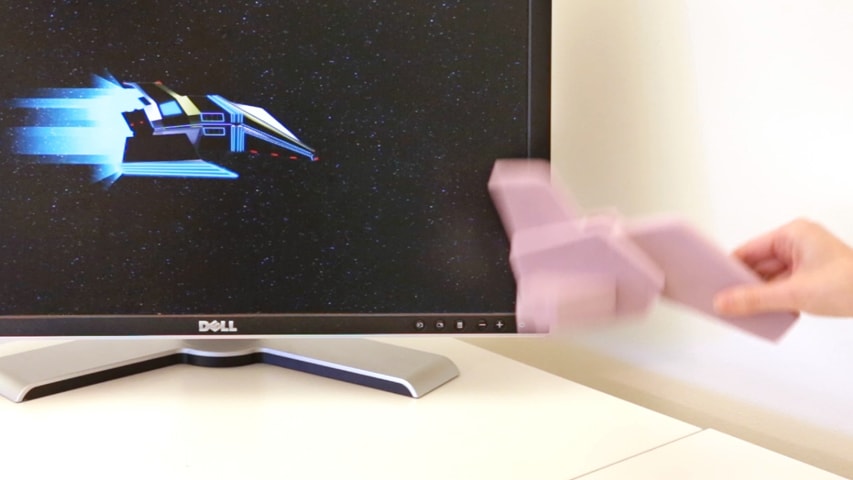Technique Processes Signals From RFID Tags With Speed Sufficient for Real-Time Interactivity
Objects Can Readily Be Made Interactive With Inexpensive Methods and Materials
By Byron Spice / Carnegie Mellon / 412-268-9068 / bspice@cs.cmu.eduand Jennifer Liu / Walt Disney Imagineering / 818-544-6130 / Jennifer.C.Liu@disney.com

A system developed by Disney Research and Carnegie Mellon University researchers uses simple RFID tags to quickly make physical objects, such as the spaceship model shown here, interactive with digital devices.
Radio-frequency identification (RFID) tags are designed primarily for inventory control, but researchers at Disney Research and Carnegie Mellon University have found a way to process the tag signals with sufficient speed to make them suitable for use in games, physical interfaces and other interactive objects.
Their technique makes it possible to use RFID tags to sense movement or touch in near real-time. The low-cost tags could thus be incorporated into slider and rotary controls for games and toys or for use in other applications that demand prompt response.
Building interactive objects usually entails circuit boards, wiring and batteries, but passive RFID tags costing as little as a dime apiece make it feasible to add interactivity to a wide variety of objects, even those made from paper or other craft materials, said Alanson Sample, research scientist at Disney Research.
“You can create interactive objects that are essentially disposable and perhaps even recyclable,” said Scott Hudson, professor in Carnegie Mellon’s Human-Computer Interaction Institute (HCII).
RFID tags also could be incorporated into durable objects, such as interactive pop-up books and toys, in which batteries or wires would be inconvenient or infeasible.
The CMU and Disney researchers will present their method at CHI 2016, the Association for Computing Machinery’s Conference on Human Factors in Computing, in San Jose, Calif., May 7-12. Passive RFID tags transmit an identifying code when they are energized by radio frequency waves from an RFID reader that can be several meters away. This method simplifies inventory tasks, but isn’t engineered to provide prompt responses.
“It gets trickier when you’re not just trying to get an ID from the tag,” said James McCann, associate research scientist at Disney Research. It’s possible to infer the trajectory of a tagged object, or whether it is being touched or covered, based on the strength, radio frequency phase and Doppler shift of the tag’s signal. But that takes precious time, which has made it difficult to use RFID tags to control games and other real-time apps.
The problem, said Jennifer Mankoff, associate professor in HCII, is that the system is dealing with highly uncertain information — the RFID reader only energizes tags at intervals, tags return signals in random order and tags don’t always return signals. Waiting for confirmation through multiple “tag reads” slows response time enough to limit many interactions.
The solution was to develop a framework, called RapID, that interprets the signals by weighing possibilities rather than always waiting on confirmation. For instance, a slider controller might work by moving an object that successively obscures the antennas of a series of RFID tags; if one obscured tag suddenly is uncovered, the system might reason that the next tag in line will be obscured.
RapID reduced typical lag times from two seconds to less than 200 milliseconds, which is similar to other interactive systems.
The researchers demonstrated the capability of RapID by instrumenting a toy spaceship, whose movements would animate an on-screen spaceship; by developing a Tic-Tac-Toe application that uses a physical game board and pieces and congratulates players when they win; and by building an audio control board that enables an interactive music-mixing experience, among other apps.
“By making it easy to add RFID-based sensing to objects, RapID enables the design of new, custom interactive devices with a very fast development cycle,” Sample said.
The RapID research team also included Andrew Spielberg, a Disney Research intern who is a Ph.D. student at MIT.
For more information and to see a video, visit the project website.